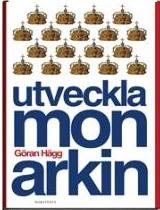 The closing of airspace just as I was about to end my stay in Copenhagen a week ago brought me unexpectedly to Gothenburg, where I found a new book, Utveckla monarkin (“Develop the Monarchy!”) by Göran Hägg, known for his many books on issues such as rhetoric, the Papacy and Mussolini.
The closing of airspace just as I was about to end my stay in Copenhagen a week ago brought me unexpectedly to Gothenburg, where I found a new book, Utveckla monarkin (“Develop the Monarchy!”) by Göran Hägg, known for his many books on issues such as rhetoric, the Papacy and Mussolini.Hägg argues that the Swedish monarchy in its current form is not working very well and that the choice made when the new Constitution was adapted in 1974 to allow the Speaker of Parliament rather than the monarch to appoint the Prime Minister was particularly unfortunate. He thinks this role should again be taken on by the head of state, which is the case in most democracies, and that some other lost monarchical traditions, such as the state opening of parliament and coronations, should be re-introduced.
However, what he proposes is a dramatically altered monarchy – nothing less than an elective monarchy with two monarchs, one male and one female, serving at the same time. The King and the Queen, who should not be married to each other, should be chosen by an electoral college made up of members of the county councils and should serve for a maximum of fifteen years.
The author argues that a monarchy is much to be preferred to a republic, partly because of its historical and traditional value, but that the hereditary principle is the greatest weakness of the current system as it risks producing incompetent heads of state.
Göran Hägg insists that he means this absolutely seriously, but when reading it one may nevertheless wonder if he is pulling one’s leg. He argues his case well, but there is not a word on how realistic he thinks it is that his ideas may be adapted, although he indicates that the 65th birthday of the current king, which is just twelve months away, could be a good occasion to implement the change.
To strengthen his argument Hägg looks at other examples of elective monarchies, such as the Papacy, and dual heads of state, including William III and Mary II of England, Scotland and Ireland and Roman consuls.
He also looks back on the history of the Swedish monarchy in order to show how rarely a monarch inherited the throne by legal means and managed to remain on it until his death – he points out that Gustaf II Adolf was the first to do so – and how frequently monarchs and heirs were indeed elected in the 16th, 17th, 18th and 19th centuries.
But his grasp on history and facts is not always firm. Queen Silvia is not German-Argentine, but German-Brazilian, none of the current King’s sisters married a count and none of his great-uncles lost their royal titles by marrying commoners. He says that the current Crown Princess may reign as either Victoria II or Victoria I, “depending on how one wishes to count the current King’s great-grandmother”, but the previous Queen Victoria was of course undisputable a queen consort (although an influential one). It is also quite odd to say that it is unclear whether the ducal titles which the King has announced will be/would have been accorded to Daniel Westling and Jonas Bergström are hereditary, as Swedish ducal titles have never been hereditary.
He states that “no-one seems to have cared” to abolish the constitutional provision for the monarch having to be a Lutheran when she state church was abolished in 2000, but seems to have missed out on the fact that this provision was maintained on the express wishes of King Carl Gustaf. And in Norway the Bernadottes were indeed increasingly considered foreigners, but it is quite startling to read that they were seen as representatives of “the occupying neighbouring country” as Norway was in a union of crowns with Sweden and never occupied by its eastern neighbour (there were in fact normally more Norwegian soldiers in Sweden than Swedish soldiers in Norway). It is also plainly wrong to say that even the most conservative political elements in Norway did everything in their powers to weaken the monarchy’s powers.
In Hägg’s opinion only two of the Bernadotte monarchs have been gifted above the average, namely Carl XIV Johan and Gustaf VI Adolf. He argues that “the least competent monarchs” of the dynasty, Carl XV and Carl XVI Gustaf, have been the most popular ones and that this is to a large extent due exactly to their lack of qualifications. But does he not forget the huge popularity of Gustaf VI Adolf, who he admits was one of the most talented of monarchs?
Such mistakes and the several facts overlooked naturally weaken the author’s arguments somewhat. But no matter the degree of clarity with which he argues his cases his proposal is of course entirely unrealistic.





No comments:
Post a Comment
Comments are welcome, but should be signed - preferably by a name, but an initial or a nick will also be accepted. Advertisements are not allowed. COMMENTS WHICH DO NOT COMPLY WITH THESE RULES WILL NOT BE PUBLISHED.